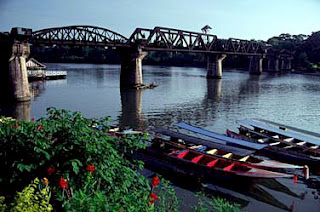 An overview of Chaing Mai, written as an introduction for people wishing to learn more about this rich and vibrant capital of the North of Thailand.
An overview of Chaing Mai, written as an introduction for people wishing to learn more about this rich and vibrant capital of the North of Thailand.
When thinking of Thailand, many of us immediately think of its hectic capital city, Bangkok. A city overflowing with so many people, traffic, fumes, sights and sounds, that all to often it can be an incredible assault on the unsuspecting tourist's senses. Yet Thailand is a country of overwhelming diversity, and thankfully located in its far north is a capital city that is light years away from the hustle and bustle of Bangkok.I am of course referring to the delightful Chiang Mai.
Chiang Mai is the capital of Northern Thailand, and it boasts a pace far more relaxed and tourist friendly than its Southern counterpart. You'll find the traffic and city pace far less frantic, and the streets a lot less confusing than Bangkok. In fact, one of the best ways for a tourist to find their way around Chiang Mai and get to know this delightful city is to hire a bicycle for the day. A most enjoyable way to see the city first hand, since everything is located in such close proximity.
There are many ways to spend your days (and indeed your foreign currency) in Chiang Mai. The city boasts a large number of glorious temples, over three hundred (or 'Wats' as they are known as in Thailand). These exquisite buildings intricately decorated with semi-precoius stones, glass and other finery are a strong attraction for many visitors to Chiang Mai. Whilse admiring these temples and their extrodinary beauty, you will also gain a richer understanding of just how firmly religion and Buddism are rooted in Thai culture and people's every day lives.
The other main attraction to Chiang Mai, and one which draws so many tourists to this Northern Thai capital is the vast array of trekking tours on offer. Chiang Mai is the starting point for many travellers of all descriptions wishing to go trekking through Thailand's luscious rain forests. Visitors have the chance to wander into the unknown and try riding upon an elephant for the first time, while also living and staying overnight with one of the many Hill Tribe communities that still live just beyond Chiang Mai. Many of these Hill Tribe people still live in the same traditional manner as they have done for centuries, and enjoying a trek can be a great way to experience first hand how these proud and fascinating people live their lives.
A word of warning though: be extremely careful when selecting your guide or company with whom to Trek with. Since so many tourists arrive in Chiang Mai with the specific intention of trekking, many companies are often "fly-by-night" operations, with their trekking packages consisting of very badly organised affairs, with tourists only seeing other tourists, while the itinary they were promised in the civilaisation of Chiang Mai not materialising in reality. Also be prepared for the fact that tourism has taken its toll on these tribes, and trekking near Chiang Mai has become a much more commercial affair in recent years. If you wish to go trekking where you will come across less tourists travelling much further north is strongly advised. Above all, if trekking, be sure to book with a reputable agent, so as to avoid later dissapointment.
Back in Chiang Mai there is so much to see and do, and shopping in one of its many markets is a fantastic way to find those unusual, yet beautiful souvenirs. The best market by far is the Chiang Mai Night Bazaar; the mother of all Chiang Mai markets. It boasts a huge range of clothing, jewelry, Thai arts and crafts - literally anything you could possibly imagine.
The Night Bazaar is also a great way to experience Thai culture in a friendly way. The stall holders all expect to barter with you for the price of an item. It can be a great way for the foreign tourist to make contact with Thai people and enjoy a friendly exchange, when often it is hard to do so with difficult language barriers.
Everything in Chiang Mai from food to accommodation is far cheaper than in its big brother Bangkok and so you will find you get far better value for money. I would also highly reccommend trying a Thai massage, which is a wonderful way to relax - especially after the rigours of an exerting Hill-trek (or a tough day sight-seeing).
As one last word of warning, do bear in mind that the climate in Chiang Mai is often far cooler than many other destinations in Thailand, so be sure to pack a sweater, or light jacket, for often you will be glad you did, but then again you could always purchase a new one at a bargain price! Whatever time of year you visit Chiang Mai be safe, be careful, but most of all have fun in this truly spectacular city, Chiang Mai - the gateway of the North!





